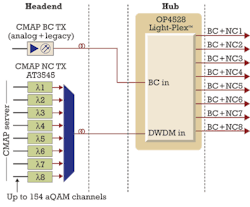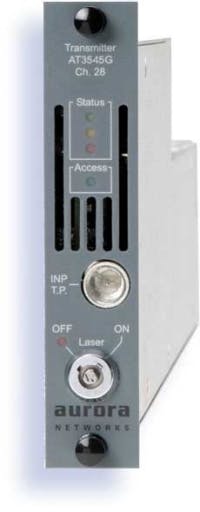By Gregory Heath
With the advent of new services and the future transition to all-IP delivery, the idea of evolving to a converged access network architecture has become popular with cable operators. CableLabs recently announced a set of consensus requirements for a new device to facilitate this evolution.
According to CableLabs, the new Converged Cable Access Platform (CCAP), a combination of the previously proposed Converged Multiservice Access Platform (CMAP) and Converged Edge Services Router (CESAR), will integrate the functions of broadcast and narrowcast quadrature amplitude modulators (QAMs), in addition to DOCSIS 3.0 downstream and upstream interfaces. It will also include the option to support PON termination equipment in the same chassis.
Meanwhile, a report from Heavy Reading Cable Industry Insider suggests the highly anticipated platform will provide a blueprint for cable operators who want to remove barriers between video and data services. The platform is expected to provide increased bandwidth efficiency and accommodate the development of new services that combine high-quality video with Internet-based offerings.
The migration to CCAP also will provide cable operators with a unique opportunity to greatly reduce the costs associated with deploying a new generation of optical components that serve both current and future needs. However, every new deployment raises questions about the best way to implement the new platform within an existing architecture. In the case of the CCAP, these questions revolve around how optical transmission resources should be allocated within the network.
Nevertheless, cable operators have access to technology today that will enable them to both cost-effectively tackle the complex integration issues stemming from the CCAP initiative and take full advantage of the new platform.
The CCAP advantage
A key advantage of the CCAP initiative is the ability to combine switching, routing, cable modem termination system (CMTS), and QAM functions at the headend so all video, voice, and data streams can be switched into IP mode as needed. Previous migration paths, such as CMTS, DOCSIS bypass, and the stacking of universal-edge QAMs for video on demand (VoD) channels for each service area could not enable cable operators to streamline services into designated narrowcast and broadcast QAM channels, or combine services to align with the ebb and flow of the market tide.
CCAP's ability to switch content prior to its conversion to RF provides cable operators with a cost-effective way to change the proportionate service allocations to QAM channels without incurring the costs and complexities of redirecting RF resources that existing architectures require. CCAP also will enable cable operators to configure service groups on a per-service basis rather than a geographic basis.
Industry architects also anticipate CCAP will enable a 200 percent increase in QAM capacity with half the rack space, and at least a 50 percent reduction in power consumption. CCAP also will enable cable operators to "mix and match" QAM channels for video, voice, and data services in a much denser way.
Though highly valuable to cable operators as they attempt to incorporate new services into their existing infrastructure, the opportunity to streamline service migrations has important implications when deciding how optical resources should be distributed within the network. While headend engineers will continue to focus on the development of CCAP specifications and implementation strategies, network engineers will have to take into account the impact CCAP will have on their overall transport architectures. The migration will also force cable operators to reevaluate their current routine purchasing decisions to avoid potential unnecessary replacement costs.
The QAM boom
Cable operators have experienced explosive growth in the number of network QAM channels. This growth is largely driven by the increase in advanced services, such as VoD and HDTV, and the deployment of switched digital video (SDV) to accommodate the expanding number of multicast content offerings. In addition, the availability of channel bonding within DOCSIS 3.0 systems has further increased the number of QAM channels cable operators deploy for their CMTS equipment.
This explosive QAM growth is just the beginning of a trend that some cable operators project could lead to requirements for 30 or more QAM channels per service area. Such estimates likely will grow in the future.
Narrowcasting and the QAM challenge
Cable operators anticipate sharp increases in narrowcast requirements for SDV, time-shifted TV programming, VoD, and bandwidth-hungry services, such as HDTV and 3DTV. They also expect to allocate more dedicated bandwidth for the channel bonding of DOCSIS 3.0 services. In addition, many are planning IPTV migration strategies that will use narrowcast bandwidth to deliver an increasing volume of premium content to the latest hybrid set-top boxes.
While increasing the number of QAM channels helps to accommodate the demands of narrowcast
and advanced services, the process has presented quite the catch-22 for today's cable operators. While cable operators want to provide subscribers with narrowcast and advanced services, they also want to reduce the size of their node service areas. However, the continued growth of advanced and narrowcast services and the processing technology that accompanies it has only further increased the number of QAMs in the headend, resulting in a power struggle for much-needed real estate.
Furthering this challenge is the fact that QAM channels are dedicated to specific services and are aggregated on a per-service basis. This makes it difficult to adjust how QAM resources are allocated. Cable operators, therefore, must scramble to adjust the load to accommodate the varying number of narrowcast channels.
CCAP challenges and solutions
Today's transport architectures require different QAM channels for the various types of narrowcast services. Advanced services such as VoD, DOCSIS data, and SDV are aggregated at the headend and transported onto wavelengths dedicated to specific nodes for delivery to the distribution hub. Narrowcast signals are handed off from each wavelength to individual fibers for distribution to each service area.
To support the increased requirements for narrowcast capacity and to take advantage of the efficiency gains CCAP will make possible, cable operators must be able to shift a much larger share of the total downstream spectrum to narrowcast lasers. However, this change can only be accomplished with today's full-spectrum transmitters (see photo). Older narrowcast transmitters simply cannot propagate across the wider RF spectrum and cannot carry more QAM channels without increasing noise and distortion levels.
Thus, no matter what optical network architecture they are using, cable operators are increasingly discovering they must replace their transmitters, either because of age or because the transmitters cannot handle today's bandwidth and segmentation requirements.
In the early years of the broadcast/narrowcast architecture, the 1550-nm directly modulated laser transmitters used for narrowcast could support RF modulation across just eight QAM channels, and provided a packing rate of just eight wavelengths per fiber. Today's full-spectrum transmitters enable cable operators to deliver up to 120 narrowcast QAM channels at a wavelength density of up to 40 per fiber, or up to 79 analog and QAM broadcast channels plus at least 75 narrowcast QAM channels over the full spectrum (albeit with a reduced number of wavelengths). These transmitters also offer greater bandwidth support, which enables cable networks to evolve to full QAM capabilities, which is a necessary component for a seamless migration to CCAP.
Another benefit to operating in the 1550-nm C-Band is the support of greater signal reach through the combination of reduced fiber attenuation and the use of EDFAs. The greater link distances, combined with the higher wavelength densities found in the 1550-nm window, provide cable operators with a cost-effective opportunity to leverage both demultiplexing and combining techniques to address today's need to migrate to deeper fiber penetration and accommodate a higher volume of narrowcast channels over time, while minimizing fiber requirements.
Cable operators can further benefit by deploying a module that merges the capabilities of a narrowcast demultiplexer with a broadcast/narrowcast splitter/combiner equipped with remote power-level management for field deployment (see Figure 1). With the number of configurations expected from CCAP deployment, this feature enables network balancing to be accomplished remotely from the Network Operations Center headend or hub without a truck-roll or services interruption.
To CCAP and beyond
The growing number of narrowcast channels required to meet today's market demands has presented significant challenges within both service and transport layer architectures. While the imminent arrival of CCAP is expected to address these challenges, cable operators will face other challenges in regards to higher-density systems.
And just as CCAP's overall goal is to reduce the costs and complexities of introducing new services, the same philosophy should guide CCAP implementation in an optical transport architecture. By applying some of the technologies discussed, cable operators will be able to maximize the bottom line benefits of CCAP, no matter what CCAP migration path they choose to follow.
GREGORY HEATH is a product manager at Aurora Networks.


